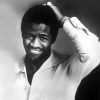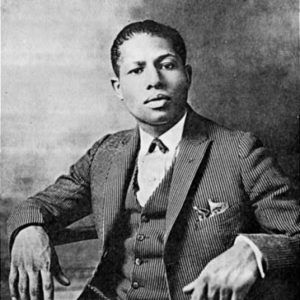calsfoundation@cals.org
Alphonso E. "Phonnie" Trent (1902–1959)
Alphonso E. “Phonnie” Trent was a nationally renowned jazz pianist and “territory” band leader from Fort Smith (Sebastian County). (“Territory” bands were those that traveled outside the large eastern markets, such as New York City.) He led the Alphonso Trent Orchestra, a group of young African American musicians who toured the country, made several recordings, and had a lengthy engagement at the Adolphus Hotel in Dallas, Texas. During that engagement, the band became the first group of Black musicians to be featured on regional broadcasts over WFAA radio in Dallas.
Alphonso Trent was born in Fort Smith on October 24, 1902, the son of E. O. Trent and Hattie S. Smith. Trent’s father was one of the first African American graduates of Ohio State University. He settled in Arkansas, eventually becoming principal of Fort Smith’s Lincoln High School in 1886.
Trent began his musical education at an early age, studying piano with local musician Professor W. O. Wiley. While still in his teens, Trent gained valuable experience as a pianist working around western Arkansas and eastern Oklahoma in Sterling Todd’s Rose City Orchestra and the Quinn Band. Because his father was a prominent educator, Trent received a strong classroom education and, in the fall of 1923, moved to Little Rock (Pulaski County) to attend Shorter College in North Little Rock (Pulaski County).
Shortly after arriving in the capital city, he began working with a group led by Eugene Crooke, called the Syncho Six. The group featured pianist Trent, Crooke playing banjo, trumpeter Edwin Swayzee, saxophonist James Jeter, vocalist John Fielding, and drummer A. G. Godley. Legendary jazz trombonist Leo “Snub” Mosley, then only fifteen years old, joined the band for a show in Helena (Phillips County). Because of Trent’s strong musical leadership and his skill at booking engagements, the band’s name was changed to the Alphonso Trent Orchestra.
In the spring of 1925, the band set out for Texas, playing street corners for nickels and dimes and an occasional dance engagement. They arrived in Dallas and played numerous low-paying dance jobs. A bellman from the Adolphus Hotel heard Trent’s orchestra at a dance. On his recommendation, the manager of the hotel booked the group for a two-week engagement in the hotel’s second ballroom. The two weeks stretched into eighteen months, a record length of time unequaled by any other African American band in the region.
As a result of the Adolphus engagement, Trent and his orchestra received exposure through broadcasts over the 50,000-watt radio station, WFAA. Trent’s broadcasts from the Adolphus were the first for an African American orchestra and reached an audience throughout the central United States and Canada.
The long engagement at the Adolphus provided the musicians a chance to rehearse and refine their musical identity. The band, which had grown to eleven musicians, had been founded as a co-op unit, a practice that was common with bands in the Southwest. All members received the same pay and were expected to contribute ideas to the development of the musical arrangements.
Under Trent’s musical direction, the band emphasized good tone quality (actual tone or timbre of the instruments), intonation (tuning of notes and chords), and showmanship. During the Adolphus engagement, Trent married Dallas native Essie Mae Grissom, whom he had met at a party held in the band’s honor. The couple never had children, but Trent had a son, Alphonso B. Trent, born in 1922 to a woman in Fort Smith.
In the summer of 1926, Trent’s orchestra left the Adolphus and toured major hotels throughout the state of Texas. The orchestra performed at the opening of a new hotel in San Antonio, the Plaza, and also performed at the inaugural ball of Texas’s first woman governor, Miriam A. Ferguson, in 1925.
Trent’s orchestra toured Texas, Arkansas, Louisiana, and Mississippi until October 1927. For the next two years, the Alphonso Trent Orchestra played in Cincinnati, Ohio; Louisville, Kentucky; Lexington, Kentucky; Buffalo, New York; and other cities. During this time, the band made its first recordings, four songs for the Gennett Company in Richmond, Indiana. The band’s publicity materials often mention recordings for the Brunswick label, but neither recordings nor information concerning the sessions have ever been located.
In the summer of 1929, the Alphonso Trent Orchestra performed at a resort in Port Stanley, Ontario. At the close of the engagement, the band headed for its one and only date in New York City, a two-week stint at the Savoy Ballroom. At the end of the two weeks, Meyer Davis offered Trent an extended run at the Arcadia Ballroom, but he refused, opting instead for a higher-paying job at the Plantation Club in Cleveland, Ohio. Trent was also fearful that other bands would steal away his musicians, a practice common among band leaders of the era.
During the engagement in early 1930 at the Plantation Club, a fire of suspicious origins consumed the establishment and destroyed the orchestra’s instruments and library. According to accounts by members of the band, a fight between rival gangs had led to an altercation between Trent and one of the gang members. As retaliation, the gang had set fire to the club.
The disastrous fire, combined with the onset of the Great Depression, caused severe hardship and contributed to the band’s ultimate demise. After the fire, the band was stranded in Cleveland without instruments. Trent’s family came to the rescue, purchasing new instruments for the group so that they could resume their careers. Jobs during these times were scarce, and the band hobbled back to Fort Smith. Trent kept his musicians busy, however, using his hometown as a base of operations.
The Alphonso Trent Orchestra made one last road trip in the winter of 1932–33, but Trent did not accompany them. It was not long, however, before Trent had another band on the road, a small group touring the Dakotas, Wyoming, Colorado, and Texas during the 1930s and early 1940s. He continued to promote young musical talent, including pioneering jazz guitarist Charlie Christian.
After World War II, Trent settled permanently in Fort Smith to manage the family’s real estate holdings and, beginning in 1953, the city’s first housing project, Elm Grove Homes. He remained active in the music business but restricted his performances to local nightclubs.
Trent died of a heart attack in Fort Smith on October 14, 1959. He is buried in the city’s Oak Cemetery. He was inducted into the Arkansas Jazz Hall of Fame in 1994.
For additional information:
“Alphonso Trent and His Orchestra.” Red Hot Jazz Archive. https://web.archive.org/web/20181026031822fw_/http://www.redhotjazz.com/atrent.html (accessed July 6, 2023).
Fitzgerald, Sarah. “Alphonso Trent—One of the Best.” Journal of the Fort Smith Historical Society 8 (April 1984): 3–6. Online at https://uafslibrary.com/fshsj/08-01_Complete_Issue.pdf (accessed July 6, 2023).
Rice, Marc. “Frompin’ in the Great Plains: Listening and Dancing to the Jazz Orchestras of Alphonso Trent, 1925–44.” Great Plains Quarterly 16 (Spring 1996): 107–115.
Rinne, Henry. “A Short History of the Alphonso Trent Orchestra.” Arkansas Historical Quarterly 45 (Autumn 1986): 228–249.
Henry Q. Rinne
University of Arkansas at Fort Smith
This entry, originally published in Arkansas Biography: A Collection of Notable Lives, appears in the CALS Encyclopedia of Arkansas in an altered form. Arkansas Biography is available from the University of Arkansas Press.



 Adolphus Hotel Orchestra
Adolphus Hotel Orchestra  Phonnie Trent
Phonnie Trent  Alphonso Trent Orchestra
Alphonso Trent Orchestra 



Comments
No comments on this entry yet.